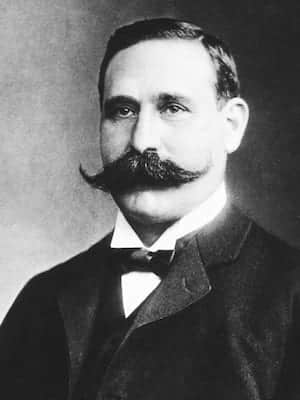Albert Hoffa

Albert Hoffa (1859-1907) was a German orthopedic surgeon.
Hoffa defined in this work the scope and methodology of orthopaedics in his Textbook of Orthopaedic surgery in 1891. He defined both operative and conservative forms of treatment; and allowed orthopaedics to gain acceptance as a special area by many physicians within German-speaking countries.
Hoffa is eponymously affiliated with a distal femur fracture (1888); an operation for congenital hip dislocations (1890); the development of a system of massage therapy, the Hoffa system (1893); and the Hoffa fat pad
Biography
- Born on March 31, 1859 Richmond, Cape of Good Hope, South Africa the son of a German physician
- Medical studies at Marburg and Freiburg
- 1886 – Founded the first private orthopedic clinic in Germany, in Würzburg, Bavaria.
- 1892 – Founded Zeitschrift Für Orthopädische Chirurgie Einschließlich Der Heilgymnastik Und Massage.
- 1895 – Associated professor in orthopaedics at Würzburg University
- 1902 – Succeeded Julius Wolff (1836-1902) as Professor in orthopaedics in Berlin
- Died December 31, 1907, in Cologne
Medical Eponyms
Hoffa fracture [Busch-Hoffa fracture] (1888)
Unicondylar coronal fracture of the lateral femoral condyle. Rare intra-articular distal femur injury. Axial compression to the knee with transmission of the ground reaction force through the tibial plateau to the femoral condyles.
Hoffa fracture: Although Hoffa did describe this fracture, he was neither the first to do so, nor did he publish his first description in 1904.
1869 – Friedrich Busch (1844-1916) described a knee joint found within the anatomical collections of the Department of Surgery in Berlin. The specimen came from the corpse of a muscular man, who died of the consequences of a severe injury sustained several years before his death. After maceration of the distal femur, a fissure separating the posterior lateral femoral condyle became visible. [Case VIII, Fig 6]

1888 – Albert Hoffa (1859-1907) allegedly used Busch’s drawing in a chapter on Fracturen des unteren Femurendes in the first edition of his textbook without citing the original source. The fracture was mentioned briefly by Hoffa in a single sentence.

Die Fracturen am unteren Ende des Femur bieten eine grosse Aehnlichkeit mit den Fracturen am unteren Ende des Humerus. Auch hier haben wir Quer- oder Schrägbrüche direct über den Condylen, traumatische Epiphysentrennungen, T- und Y-förmige Fracturen und Brüche eines oder beider Condylen. Dazu kommt dann noch eine Reihe unvollständiger BrücheEs handelt sich bei denselben um Fissuren, welche in der Regel in der Längsrichtung des Knochens verlaufen. Sie beginnen im Gelenk, gewöhnlich in der Mitte zwischen beiden Condylen, durchsetzen den Gelenkknorpel und eine mehr oder weniger lange Strecke der Epiphyse, reichen auch wohl in die Diaphyse hinein oder umgrenzen den grÖssten Theil eines Condylus (Fig. 250).
Fractures at the lower end of the femur bear a strong resemblance to fractures at the lower end of the humerus. Here, too, we have transverse or oblique fractures directly above the condyles, traumatic epiphyseal separations, T- and Y-shaped fractures, and fractures of one or both condyles. In addition, there are a number of incomplete fractures. These are fissures that generally run in the longitudinal direction of the bone. They begin in the joint, usually midway between the two condyles, penetrate the articular cartilage and a more or less extensive stretch of the epiphysis, and may also extend into the diaphysis or enclose the greater part of a condyle (Fig. 250).
Hoffa’s syndrome (Hoffa fat pad impingement) (1904)
The Hoffa fat pad (infrapatellar fat pad (IFP)), is a cushioning structure located behind the patella within the knee joint. It is composed of fatty tissue surrounded by connective tissue and its primary function is to absorb shock and help distribute pressure across the knee, thereby maintaining joint stability and function.
Hoffa fat pad syndrome, aka Hoffa’s disease, infrapatellar fat pad syndrome, or Hoffa pad impingement syndrome, Hoffa’s syndrome is painful impingement of the infrapatellar fat pad between the patella and distal femoral condyle.
Hoffa presented at the Fifty-fifth Annual Session of the American Medical Association in the Section on Surgery and Anatomy. His paper highlighted disturbances of the knee joint caused by the adipose
tissue and his operative methods of removal. [Hoffa A. Influence of adipose tissue with regard to the pathology of the knee joint. JAMA. 1904;43:795–796.]
Hoffa System of therapeutic massage (1893)
Hoffa A. Technik der Massage. 1893
Major Publications
- Hoffa A. Die Natur des Milzbrand-Giftes. 1886
- Hoffa A. Lehrbuch der fracturen und luxationen für ärzte und studierende. 1888 [Hoffa fracture: Fracturen des unteren Femurendes]
- Hoffa A. Zur operativen Behandlung der angeborenen Hüftgelenks-verrenkungen mit Krankenvorstellung. Wiener Medizinische Presse. 1890; XXXI: 763
- Hoffa A. Technik der Massage. 1893
- Hoffa A. Lehrbuch der orthopädischen Chirurgie. 1894
- Hoffa A. Atlas und Grundriss der Verbandlehre für Studierende und Aerzte.1897
- Hoffa A. Die Endresultate meiner letzten blutigen Operation der angeborenen Hüftgelenksluxation. Deutsche medizinische Wochenschrift 1897; XX: 305, 326
- Hoffa A. Die moderne Behandlung der angeborenen Hüftgelenksverrenkungen. Archiv für klinische chirurgie. Berlin 1899; LIX: 525—542.
- Hoffa A. Influence of adipose tissue with regard to the pathology of the knee joint. JAMA. 1904;43:795–796. [Hoffa fat pad]
- Hoffa A, Rauenbusch L. Atlas der orthopädischen Chirurgie in Röntgenbildern. 1905
- Hoffa A, Blencke E. Die orthopädische literatur. 1905
- Hoffa A. Orthopädische Chirurgie. Band I, Band II. 1921
References
Biography
- Pagel J. Hoffa, Albert. Biographisches Lexikon hervorragender Ärzte des neunzehnten Jahrhunderts. 1901: 768
Eponymous terms
- Thomann K. [A Modern Textbook Is 100 Years Old. Albert Hoffa and the “Textbook of Orthopedic Surgery”] Z Orthop Ihre Grenzgeb. 1992; 130 (4): 339-44
Eponym
the person behind the name
